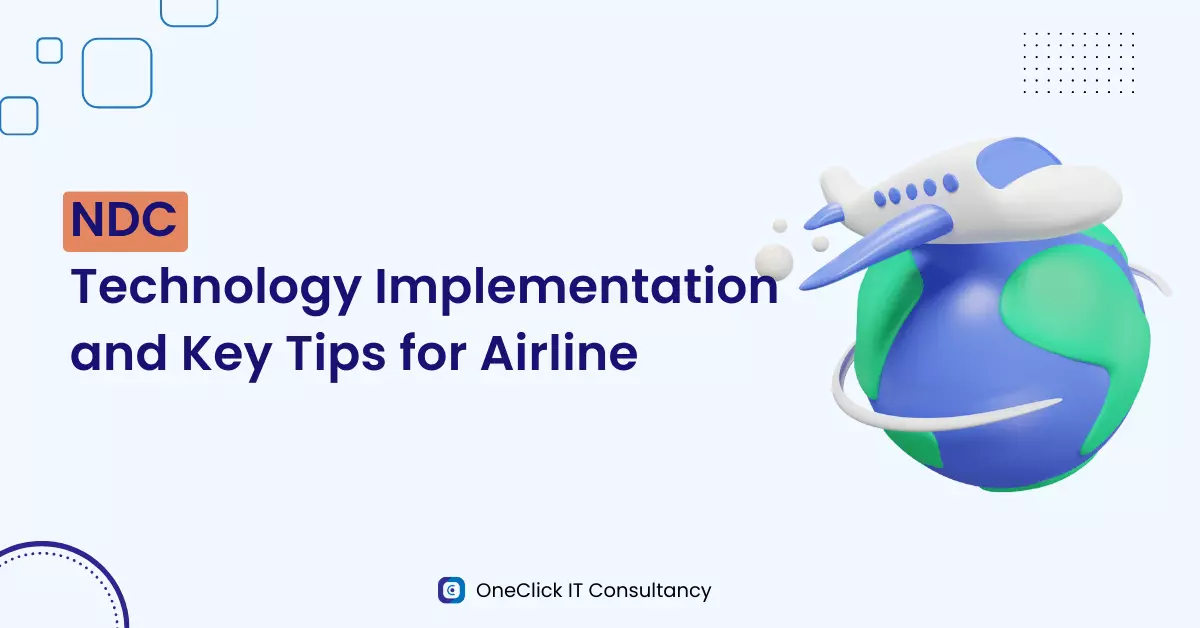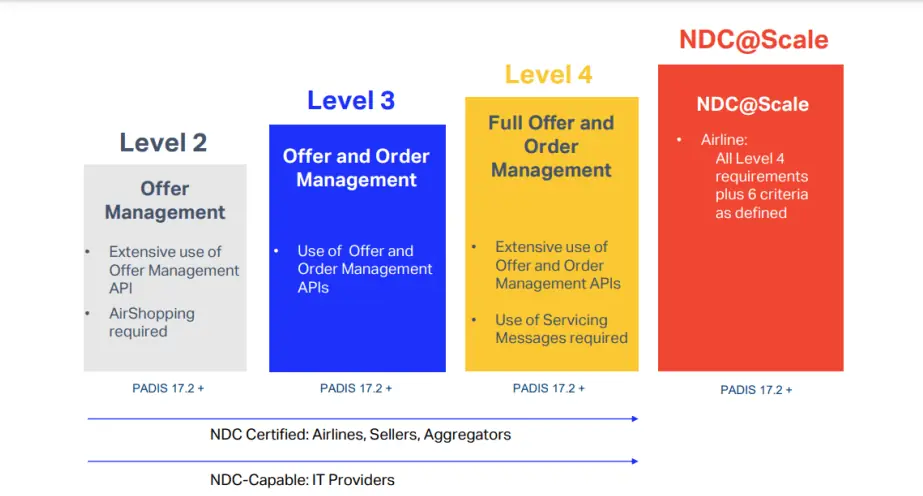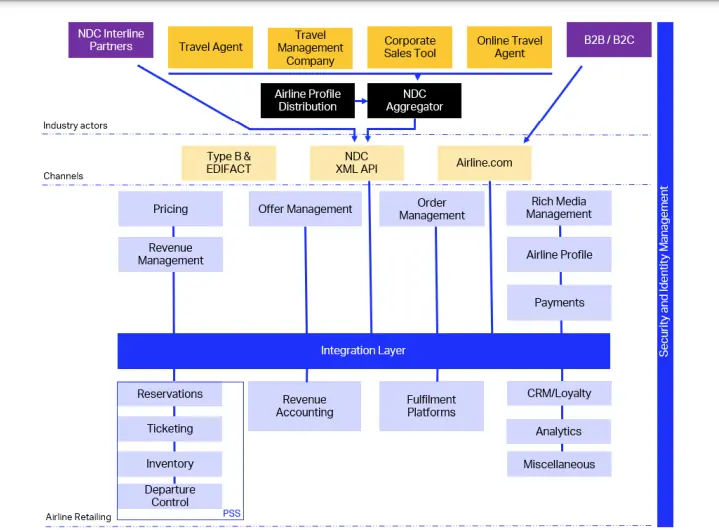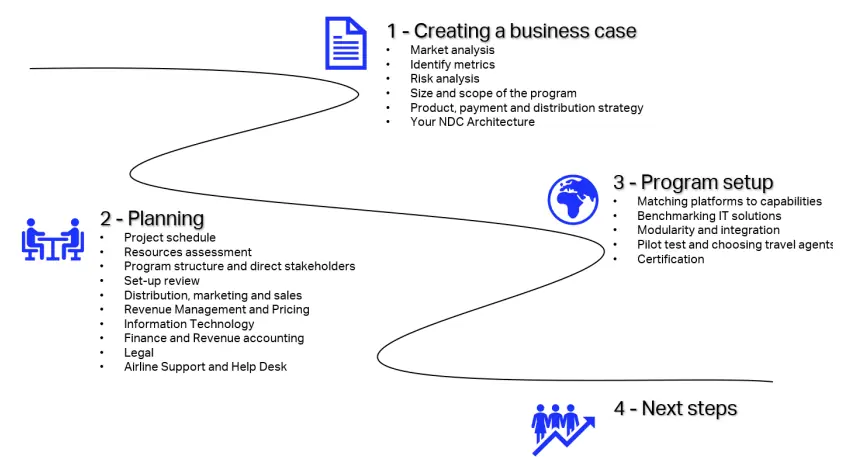NDC: Technology Implementation and Key Tips for Airline

Understanding NDC: A Paradigm Shift in Airline Distribution
New Distribution Capability (NDC), championed by the International Air Transport Association (IATA), is a pivotal initiative aimed at establishing an XML-based data transmission standard within the travel industry. Engineered to amplify data exchange, NDC empowers airlines to disseminate their offerings through indirect sales channels with the same precision as direct sales. This standardized protocol elevates communication between airlines and travel agents, allowing third parties, intermediaries, IT providers, and non-IATA members to embrace and implement NDC.
The crucial role of NDC for airlines lies in its ability to reshape the landscape of air product retailing. It effectively addresses the industry’s prevailing challenges, encompassing rapid product differentiation, expedited time-to-market, unobstructed access to comprehensive air content, and a foundational aspect: a shopping experience that radiates transparency.
OneClick’s IATA CERTIFIED NDC services

NDC’s Impact on Airline Distribution Landscape
New Distribution Capability (NDC) engenders a pivotal shift in how airlines distribute their offerings, forging direct connections between airlines and distribution partners such as travel agencies. This transformative approach reconfigures the traditional distribution process, steering away from the conventionally central role of Global Distribution Systems (GDSs) as intermediaries.
Advantages of NDC Adoption for Airlines
NDC implementation offers airlines an array of advantages that include:
Enhanced Revenue Generation
By leveraging NDC, airlines attain amplified control over product pricing and availability, translating into increased revenue streams.
Augmented Customer Service
NDC equips airlines with the capability to provide tailor-made products and services, elevating the caliber of customer service rendered.
Operational Efficiency Boost
Streamlining the distribution process, NDC enables airlines to elevate operational efficiency, fostering smoother workflows.
Data Analytics Enrichment
NDC augments airlines’ data analytics prowess by furnishing comprehensive insights into product and service performance, facilitating informed decision-making.
Regulatory Compliance Enhancement
The adoption of NDC facilitates airlines in adhering to industry regulations through standardized product distribution practices.
The strategic embrace of NDC positions airlines for a competitive edge, catalyzing a positive transformation in their overall performance metrics.
NDC Certification Process

Key Components of NDC Implementation
NDC Messaging Standards and Protocols
NDC messaging standards are rooted in Offer and Order management processes, enabling airlines to generate and distribute tailored offers to customers across distribution channels. The NDC messaging protocol is engineered to facilitate more streamlined communication between airlines and travel agents.
Data Synchronization and Schema Adoption
Data synchronization emerges as a cornerstone of NDC implementation, ensuring that all stakeholders involved in the distribution process access identical data concurrently. Schema adoption pertains to the embrace of a unified data structure, expediting seamless communication between diverse systems.
Offer and Order Management Capabilities
Offer management capabilities empower airlines to craft personalized offerings based on customer preferences. Order management capabilities facilitate more efficient management of customer orders by airlines.
Making Travel Shopping Better
These cardinal components form the bedrock for a successful NDC implementation, heralding a transformative era in the travel industry. NDC’s impact transcends prevailing distribution constraints, encompassing prompt product differentiation, expedited time-to-market, unfettered access to comprehensive air content, and an aspect – a shopping experience characterized by transparency.
1. Assessing Current Capabilities
Evaluating existing distribution systems and processes
Airlines undertake a comprehensive assessment of their prevailing distribution systems and processes. This entails scrutinizing the mechanisms responsible for booking, pricing, and managing inventory. This evaluation aims to pinpoint any existing gaps or limitations that warrant attention.
Identifying Limitations in the Current Distribution Model
Airlines engage in the task of recognizing any drawbacks or constraints present in their ongoing distribution model. This encompasses pinpointing areas where they lack authority over the pricing and availability of their offerings. Moreover, it involves identifying domains where tracking the performance of their products proves challenging.
Analyzing the impact of NDC compliance on business operations
Airlines delve into a thorough analysis of how adhering to NDC guidelines influences their business operations. This encompasses a comprehensive assessment of its repercussions on their IT systems, sales and marketing strategies, and customer service endeavors. This assessment aims to elucidate the potential shifts and enhancements brought about by NDC compliance.

OneClick’s Expert Insight
To achieve optimal NDC compliance, airlines can adopt a structured approach to assess their capabilities, bridge distribution gaps, and anticipate the influence of NDC compliance on business operations.
1. Comprehensive Gap Analysis
Commence by conducting a meticulous gap analysis. This process involves scrutinizing your current capabilities against NDC compliance requisites. Compare existing systems and practices to the NDC standard to identify disparities.
2. Strategize with a Roadmap
Develop a strategic roadmap tailored to NDC compliance. This roadmap serves as a guide, outlining the sequential actions necessary for seamless NDC integration.
3. Securing Stakeholder Support
Secure buy-in from pivotal stakeholders like IT, sales, and marketing teams. Their support ensures a unified effort towards successful NDC implementation.
4. Gradual Testing and Rollout
Opt for a phased approach in testing and implementing NDC compliance. This gradual deployment minimizes disruptions to your ongoing operations.
5. Continual Vigilance and Refinement
Vigilantly monitor the NDC compliance execution. Continuously assess its impact and refine strategies as needed to optimize benefits.
As you develop your strategic roadmap, consider consulting with NDC certified partners like OneClick. Our certification has equipped us with the knowledge to draft a roadmap that’s aligned with the latest NDC standards.
NDC Reference Architecture

2. Building an Implementation Strategy
Establishing Clear Goals and Objectives
Airlines commence by formulating unequivocal goals and objectives for NDC adoption. This strategic delineation ensures the efficacy of the implementation. These objectives ought to embody specificity, measurability, achievability, relevance, and a definitive time frame.
Structuring a Phased Implementation Approach
Airlines delineate a structured, phased approach for the NDC implementation. This strategy minimizes the disruptions to ongoing business operations. The phased approach initiates with a pilot project, followed by a gradual rollout of NDC compliance across all channels.
Designating Roles and Responsibilities
Airlines map out distinct roles and responsibilities within the organizational framework. This delineation fosters seamless coordination and assures that each contributor is cognizant of their tasks. Clarity and conciseness are the hallmarks of these designated roles and responsibilities.
OneClick’s Expert Insight
To formulate a tailored NDC adoption strategy, airlines can execute the following pragmatic steps:
1. Analyzing Stakeholder Dynamics
Commence by conducting a comprehensive stakeholder analysis. This entails identifying the array of stakeholders who will be impacted by NDC compliance. This roster encompasses both internal entities—such as IT, sales, and marketing teams—and external actors like travel agents and passengers.
2. Defining Clear Goals and Objectives
Articulate the precise goals and objectives entailed in NDC compliance. Collaborate with stakeholders during this definition phase, ensuring alignment with their insights and input.
3. Structuring a Phased Implementation Approach
Develop a structured, phased approach for execution. Kick off with a pilot project, and subsequently roll out NDC compliance incrementally across all operational channels. This stepwise progression minimizes business disruption.
4. Designating Roles and Responsibilities
Clearly outline the roles and responsibilities of each stakeholder involved. This collaborative definition guarantees everyone understands their contributions and the coordinated execution of tasks.
5. Garnering Stakeholder Support
Obtain the endorsement of all stakeholders, thereby fostering a unified approach to successful NDC implementation.
By adhering to these pragmatic steps, airlines lay the foundation for an NDC implementation strategy that is characterized by clarity, precision, and effectiveness.
3. Technology Infrastructure Alignment
Assessing Technology Stack Compatibility
Begin by evaluating your existing technology stack to ascertain its compatibility with NDC. This entails a comprehensive analysis of your current systems and processes. Pinpoint areas that may require enhancements to seamlessly accommodate NDC.
Upgrading and Integrating for Fluid Data Exchange
Elevate your systems by either upgrading or integrating them to facilitate fluid data exchange between airlines and travel agents. Embrace new technologies and industry standards that foster efficient communication across diverse systems, ensuring a cohesive network.
Addressing IT challenges and considerations
As you embark on NDC implementation, anticipate and address potential IT challenges. This includes fortifying your IT infrastructure to cope with the heightened data volume and transaction demands that NDC brings to the forefront. By ensuring your technology infrastructure is primed for NDC implementation, airlines position themselves to harness the full spectrum of benefits that NDC offers.
OneClick’s Expert Insight
1. Building the Foundation for NDC Success
To ensure successful implementation of New Distribution Capability (NDC), airlines can consider taking these specific steps outlined here:
2. Assessing Current Capabilities
Thoroughly assess your current distribution systems and processes. Identify gaps and limitations within your prevailing distribution model. Delve into the impact of NDC compliance on your business operations.
3. Crafting a Strategic Implementation Approach
Craft a meticulous implementation strategy. This entails setting precise goals and objectives for NDC adoption, devising a phased implementation approach, and clearly delineating roles and responsibilities within your organization.
4. Ensuring Technology Infrastructure Readiness
Anchor your NDC aspirations in a technologically adept infrastructure. Gauge your technology stack’s compatibility with NDC. Seamlessly integrate or upgrade systems to facilitate data exchange. Address potential IT hurdles proactively.
As you journey through these steps, you’ll ensure a robust foundation for NDC integration, optimizing the benefits this paradigm shift bestows upon the airline industry.
4. Collaboration with Distribution Partners
Engaging with GDSs and Third-Party Providers
Forge connections with Global Distribution Systems (GDSs) and third-party providers, a pivotal step in enabling NDC content distribution. Collaborate with GDSs to craft NDC APIs, and with third-party providers to design NDC-enabled solutions.
Establishing Mutually Beneficial Partnerships
Strengthen your capabilities by forming alliances with fellow airlines, travel agents, and technology providers. Such partnerships fuel NDC content distribution, alleviating the cost and complexity associated with NDC implementation.
Skillful Negotiation of Terms and Agreements
Master the art of negotiation as you define terms and agreements with your distribution partners. These negotiations encompass pricing structures, service terms, and data sharing arrangements to ensure a balanced and productive partnership.
OneClick’s Expert Insight: Succeeding in Distribution Partnerships
Airlines can unlock the potential of collaborative partnerships through these targeted actions:
1. Identify Potential Partners
Begin by identifying potential partners who share your interest in NDC. This encompassing scope includes GDSs, third-party providers, and other airlines who align with your vision.
2. Evaluate Partners
Conduct a thorough evaluation of potential partners to ascertain their compatibility with your NDC journey. Assess their capabilities, track record, and commitment to the NDC cause.
3. Navigate Terms and Agreements
Engage in open and transparent negotiations with prospective partners. Define clear terms, laying out the parameters of collaboration, mutual responsibilities, and how each party will contribute to the partnership’s success.
4. Monitor and Nurture Partnerships
Once collaborations are established, diligent monitoring ensures that partnerships remain effective. Manage these relationships to ensure they continue to meet your airline’s evolving needs.
By adopting these strategic approaches, airlines can harness the power of collaborative efforts, ensuring that the NDC compliance journey is beneficial for all stakeholders involved.
New Distribution Capability(NDC) Roadmap

5. Data Security and Compliance
Safeguarding Data Privacy and Security in NDC Transactions
As airlines delve into NDC transactions, safeguarding customer personal data takes precedence. Measures encompassing robust encryption, vigilant access controls, and compliance with data privacy regulations are paramount.
Industry Regulations and Standards Adherence
Airlines must align with industry mandates during NDC implementation. Notably, compliance with General Data Protection Regulation (GDPR), Payment Card Industry Data Security Standard (PCI DSS), and IATA Data Protection Guidelines for NDC are critical.
Enforcing Encryption and Access Controls
Airlines must fortify data security by integrating formidable encryption mechanisms into NDC data exchange. Equally crucial is the imposition of stringent access controls, guaranteeing restricted data access only to authorized personnel.
OneClick’s Expert Insight: Ensuring Data Security and Compliance
Here are precise actions airlines can take to enhance data security and compliance in NDC:
1. Craft a Data Security Policy
Articulate a comprehensive data security policy that delineates the organization’s commitment to safeguarding personal data. This policy should encompass protocols such as encryption, access controls, and data breach management.
2. Encryption Implementation
Employ robust encryption for all NDC data – both in transit and at rest. This fortification ensures unauthorized access and use are thwarted.
3. Access Controls Enactment
Enforce access controls to circumscribe NDC data access to authorized entities. This rigid control framework ensures that data is accessible only to approved individuals.
4. Vigilant Security Threat Monitoring
Deploy vigilant monitoring mechanisms to detect potential security breaches promptly. This proactive approach enables swift identification and mitigation of data security risks.
5. Employee Data Security Training
Inculcate data security best practices within your workforce through comprehensive training. This equips employees with an acute understanding of the significance of safeguarding personal data.
By methodically embracing these steps, airlines erect a robust defense mechanism, ensuring that their NDC implementation resonates with security and adherence to pertinent regulations.
6. Staff Training and Change Management
Educating employees about NDC concepts and benefits
Recognizing the pivotal role of a well-informed workforce, airlines must proactively educate their employees about NDC’s concepts and the myriad benefits it brings to the aviation landscape. By providing comprehensive insights into NDC, airlines ensure their employees understand the driving force behind this transformation.
Addressing concerns and resistance to change
Navigating change can often be met with apprehension and resistance. Airlines must anticipate these apprehensions and proactively address them. Transparently communicating the tangible advantages that NDC offers can dispel doubts and fears. Offering targeted training sessions tailored to employees’ roles and needs can help ensuring a seamless transition, fostering confidence and buy-in.
Providing training on new systems and processes
As the backbone of NDC adoption, training becomes paramount. Airlines must craft a comprehensive training curriculum that not only imparts knowledge about the new systems and processes but also empowers employees with hands-on experience. Through focused training, employees can gain a deep understanding of how NDC interfaces with their daily operations.
OneClick’s Expert Insight: Fostering Employee Readiness for NDC
Here are tailored measures airlines can adopt to educate, address concerns, and provide training:
1. Formulate an NDC Training Plan
Design a comprehensive training plan that delineates the training topics, duration, and resources required. This plan serves as a roadmap to ensure no essential aspect is overlooked.
2. Universal Training
Extend training to all employees who will be impacted by the NDC transition. From sales and marketing teams to reservations and IT, inclusive training ensures cohesive understanding and readiness.
3. Diverse Training Approaches
Recognize that different employees learn differently. Blend various training methodologies, from traditional classroom sessions to interactive online modules and practical hands-on training, to cater to diverse learning styles.
4. Interactive Learning
Elevate engagement by integrating interactive elements into training. Incorporate real-world case studies, interactive exercises, and knowledge-check quizzes to reinforce learning and practical application.
5. Ongoing Support
Remember that learning doesn’t conclude with the training sessions. Extend post-training support through dedicated helpdesk assistance, readily available troubleshooting resources, and periodic refresher training to ensure lasting proficiency.
By adhering to these insightful strategies, airlines can fortify their workforce for a successful NDC implementation, ensuring a seamless shift and the realization of its manifold benefits.
7. Testing and Quality Assurance
Crafting Comprehensive Test Scenarios for NDC Messaging
A pivotal phase in NDC implementation involves devising meticulous test scenarios for NDC messaging. This meticulous process aims to leave no stone unturned, ensuring the NDC framework is subjected to diverse scenarios. These scenarios encompass a spectrum of messages, ranging from crucial flight status updates to fare quotes and booking confirmations.
Conducting rigorous testing of NDC transactions
The bedrock of successful NDC implementation is meticulous testing of transactions. Airlines must conduct rigorous assessments to validate the accuracy and reliability of the system. Employing a repertoire of testing methodologies, including unit testing, integration testing, and system testing, empowers airlines to subject NDC transactions to a battery of checks.
Ensuring Unwavering Precision and Dependability
Airlines must maintain unerring precision and unwavering reliability in NDC-enabled processes. To achieve this, constant monitoring of system performance becomes paramount. This involves vigilant oversight and swift adjustments whenever needed, ensuring that NDC processes deliver the desired outcomes seamlessly.
OneClick’s Expert Insight: Pioneering Seamless NDC Implementation
Incorporating robust test scenarios and conducting comprehensive testing for NDC transactions are pivotal to a successful implementation. Here’s a roadmap of actions airlines can undertake:
1. Identify Diverse Message Types
Pinpoint the spectrum of NDC messages that necessitate testing. This inclusive approach ensures comprehensive coverage of scenarios.
2. Develop Targeted Test Cases
Craft specific test cases for each message type, delineating expected outcomes meticulously. This strategic approach streamlines testing and validation.
3. Leverage Varied Testing Tools
Harness an array of testing tools and techniques to achieve a holistic assessment of NDC implementation’s robustness.
4. Continuous Performance Monitoring
Adopt proactive performance monitoring to ensure the accuracy and reliability of NDC-enabled processes. This vigilant oversight allows prompt identification and rectification of any discrepancies.
5. Adaptive Adjustments
Remain agile in adapting to the system’s performance insights. Swift adjustments and fine-tuning guarantee that NDC processes consistently meet the highest standards of precision and reliability.
By threading these actions into their implementation strategy, airlines can elevate their NDC journey, ensuring thorough testing and unwavering dependability in their NDC-enabled processes.

8. Deployment and Monitoring
Strategizing Multichannel Rollout
Airlines embark on the strategic voyage of formulating a comprehensive rollout plan for NDC across diverse channels. This meticulous planning ensures a methodical and controlled implementation process. The blueprint of the rollout plan encompasses a well-defined timeline, allocated resources, and a strategic approach to mitigate potential risks.
Continual Surveillance of NDC Transactions and Performance
To secure NDC’s sustained efficacy, airlines must engage in continuous monitoring of transactions and performance. This ongoing vigilance ensures that the NDC implementation functions seamlessly and any anomalies are promptly detected and resolved. The monitoring ecosystem employs an array of tools and techniques, including logging, metrics analysis, and real-time alerts.
Swift resolution of any technical issues
In preparation for any unforeseen technical hiccups, airlines establish a swift resolution protocol. This comprehensive mechanism ensures the rapid identification and rectification of technical issues, minimizing disruption to operations. A well-documented process, complete with delineated roles and responsibilities, underpins this resolution strategy.
OneClick’s Expert Insight: Propelling Effortless NDC Deployment
Our expertise crystallizes the roadmap to effective NDC deployment and vigilant monitoring:
1. Channel Identification
OneClick works closely with the airlines to thoroughly identify all the channels such as the airline’s website, mobile application, and travel agent partnerships through which NDC will be implemented. By carefully evaluating each channel, OneClick is able to determine the best path for NDC rollout for maximum impact.
2. Strategic Timeline
Based on the channels selected, OneClick develops a comprehensive strategic timeline for NDC implementation to ensure systematic and well-timed execution of the rollout plan. The timeline is crafted considering factors like resource availability, testing requirements, and launch priorities to facilitate a smooth NDC launch.
3. Resource Allocation
OneClick helps airlines identify and allocate key resources ranging from IT experts to marketing and sales teams required for NDC implementation. By allocating the right resources at the right time, airlines can achieve their NDC goals efficiently.
4. Risk Mitigation Blueprint
OneClick creates a robust risk mitigation plan for airlines including extensive testing measures and backup strategies to handle any contingencies. The risk blueprint developed by OneClick’s experts covers all areas of NDC implementation to guarantee a risk-free NDC launch for airlines.
5. Performance Monitoring
OneClick provides airlines with a comprehensive monitoring system that employs tools such as logging, metrics analysis, and real-time alerts to vigilantly monitor NDC performance post-launch. Continuous monitoring is essential to promptly detect and fix any issues, ensuring maximum uptime and seamless NDC operations.
6. Swift Technical Issue Resolution
OneClick establishes a dedicated technical team responsible for rapid resolution of any issues arising, guaranteeing uninterrupted NDC services for airlines. With a specialized technical team on standby, airlines can rest assured that OneClick will promptly attend to any technical challenges and restore operations immediately.
By embracing these strategic measures meticulously crafted by OneClick, airlines can achieve a successful NDC deployment, consistent performance monitoring, and swift resolution of technical difficulties, ensuring a hassle-free NDC implementation journey.
9. Measuring Success and ROI
Upward Surge in Direct Bookings
Airlines can gauge the impact of NDC adoption by monitoring the rise in direct bookings made through their proprietary channels – the airline’s website or mobile app.
Enhanced Customer Satisfaction
The yardstick of customer satisfaction surveys aids airlines in comprehending the impact of NDC adoption on customer experiences. Analysis of these surveys gauges whether customers find the NDC experience more satisfactory.
Amplification of Revenue Streams
Tracking revenue stands as a potent metric to gauge NDC adoption’s impact. This entails monitoring whether the airline’s revenue has witnessed an upswing since embracing NDC.
Streamlined Cost Reduction
Airlines can track whether the adoption of NDC has led to cost reductions. This entails keeping a watchful eye on expenditure trends to ascertain if they have decreased post-NDC adoption.
Assessing Elevation in Customer Satisfaction and Sales
Airlines can conduct surveys and scrutinize data to evaluate the elevation in customer satisfaction and sales. By assessing customer feedback and analyzing data patterns, airlines can quantify the improvement in customer satisfaction and the potential increase in direct bookings.
Calculating Return on Investment (ROI) from NDC Compliance
The return on investment from NDC compliance can be quantified by correlating the tracked metrics with the implementation costs. For instance, if an airline invests $1 million in NDC and witnesses a revenue increase of $2 million, the ROI stands at 100%.
OneClick’s Expert Insight: Quantifying NDC’s Impact!
Our seasoned expertise in NDC implementation empowers airlines to not only adopt but harness its transformative potential. We offer nuanced guidance through these actionable steps:
1. Comprehensive Alignment of Goals and Objectives
Begin with the end in mind. OneClick’s experts work closely with airlines to set clear, measurable goals and objectives for NDC implementation. This foundational step ensures that every effort is focused on achieving tangible outcomes, making the measurement process purposeful and effective.
2. Strategic Data Collection and Analysis
OneClick understands that robust data forms the bedrock of informed decisions. Our experts guide airlines in meticulously collecting and collating data from diverse sources. This ranges from post-implementation customer surveys to dissecting revenue figures and analyzing operational efficiencies. By structuring data collection methodologies, airlines are empowered to draw meaningful insights.
3. Precise Data Interpretation
Data without context is mere numbers. OneClick’s experts delve deep into the data ocean, meticulously analyzing patterns, trends, and correlations. This profound analysis is the key to understanding the true impact of NDC adoption – whether it’s a surge in direct bookings, improved customer sentiment, or augmented revenue streams.
4. Bespoke Actionable Recommendations
OneClick doesn’t just stop at analysis; we empower airlines with actionable recommendations. These insights aren’t confined to the abstract – they’re tailor-made strategies, adjustments, and enhancements that stem from data-driven insights. This ensures airlines can fine-tune their NDC implementation for maximum impact.
5. Adaptation for Continued Success
Quantifying NDC’s impact is a journey, not a destination. OneClick’s experts understand that the aviation landscape evolves, and so should NDC strategies. We guide airlines in interpreting the quantified impact to adapt, refine, and optimize their NDC approach, ensuring continued success and growth.

Future Trends in NDC and Distribution
The horizon of New Distribution Capability (NDC) and airline distribution is brimming with potential, as a tapestry of emerging trends prepares to reshape the industry in the years to come. Here’s a closer look at some of these transformative trends:
Personalization
Personalization is poised to take center stage in airline distribution. NDC will empower airlines to craft tailored offers, weaving individual preferences and travel history into a seamless booking experience.
Artificial Intelligence (AI)
AI is set to become a pivotal player in the future of airline distribution. By delving into customer data, Artificial Intelligence (AI) will curate personalized recommendations for travel products and services, elevating customer experiences.
Blockchain Technology
The disruptive potential of blockchain is bound to redefine airline distribution. With its secure and transparent transaction platform, blockchain can safeguard customer data while facilitating smooth information exchange between airlines and travel agents.
Mobile-friendly Technology
As mobile devices become an extension of our lives, airlines are gearing up to harness mobile platforms as the primary channel for distribution. This shift ensures customers a seamless booking journey, right at their fingertips.
Virtual Reality (VR)
The allure of Virtual Reality (VR) is poised to transform how customers interact with travel offerings. Providing immersive glimpses into travel experiences, VR will shape a novel dimension of airline distribution.
Curious about the future of airline distribution? OneClick’s NDC implementation has it all: tailored experiences, AI-powered insights, blockchain assurance, mobile ease, and captivating virtual reality. Get ahead in distribution with us!
Staying Ahead: Navigating Emerging Trends and NDC Evolution
To thrive in this evolving landscape, airlines need to navigate these trends strategically:
1. Stay Informed
Vigilantly monitor the industry by engaging with industry publications, attending conferences, and networking with peers. This keeps you well-informed about emerging distribution trends.
2. Invest in Innovation
Embrace innovation through research and development. Invest in technologies like NDC and experiment with novel distribution strategies to keep your offering ahead of the curve.
3. Flexibility and Adaptability
In an ever-changing landscape, agility is paramount. Be open to adopting new technologies and strategies to remain relevant and competitive.
4. Forge Collaborative Partnerships
Forge alliances with stakeholders like travel agents and technology providers. Collaborative partnerships pool resources, knowledge, and innovation to pioneer novel distribution solutions.
As the NDC ecosystem evolves, so do the ways airlines connect with their customers. By staying attuned to emerging trends and embracing the transformative power of NDC, airlines can seize the future of airline distribution with confidence and innovation.
Revolutionize Personalization with OneClick
At OneClick, we understand that the future of airline distribution revolves around personalization. Why settle for a one-size-fits-all approach when you can offer customized experiences that resonate with each traveler? With OneClick you can:
- Elevate your airline’s strategy with our proven expertise.
- Embrace NDC to pioneer novel distribution strategies.
- Keep your services ahead of the curve and customer-centric.
- Collaborate with industry stakeholders and technology experts.
- Forge a successful path in the evolving landscape of airline distribution.
Our NDC implementation services are specifically engineered to facilitate tailored offerings based on individual preferences and travel history. With OneClick by your side, you can deliver a seamless booking experience that sets you apart. Shouldn’t we now talk about taking your personalization strategy to the next level?





